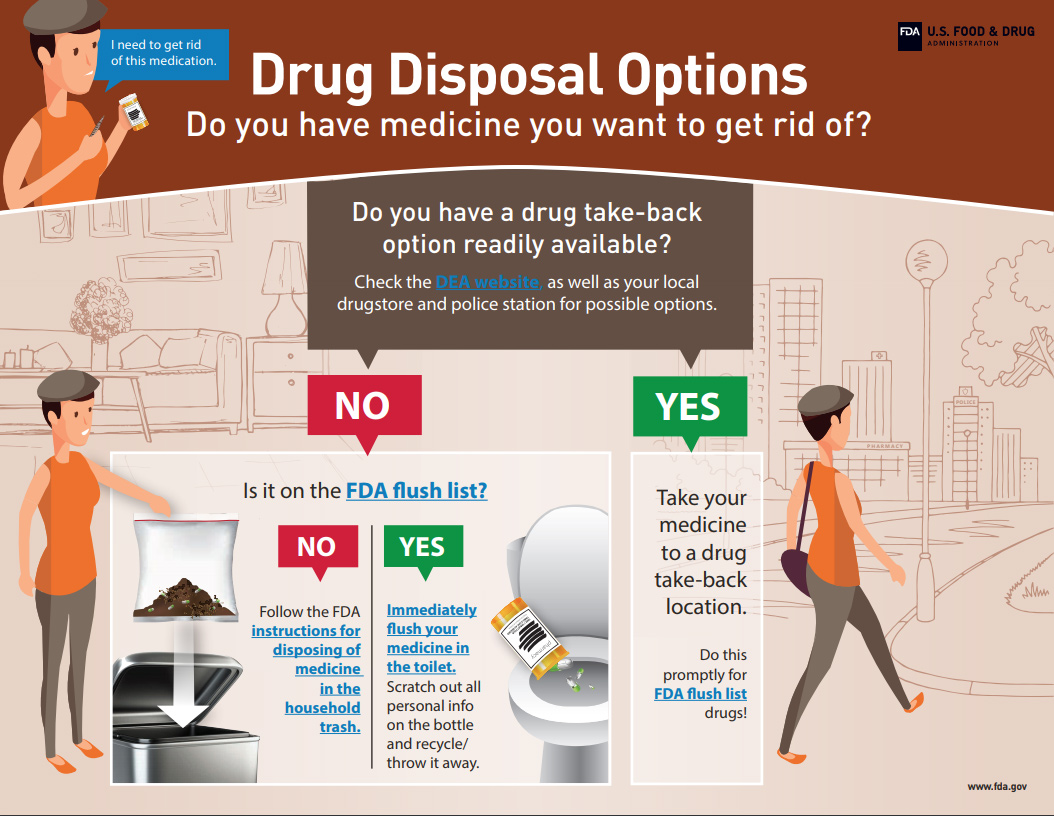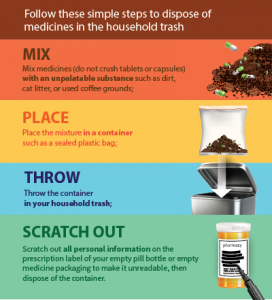When your medicines are no longer needed, they should be disposed of promptly. Consumers and caregivers should remove expired, unwanted, or unused medicines from their home as quickly as possible to help reduce the chance that others accidentally take or intentionally misuse the unneeded medicine, and to help reduce drugs from entering the environment.
Below, we list some options and special instructions for you to consider when disposing of expired, unwanted, or unused medicines. For more information visit the FDA website HERE
Your best choices for disposal of unused or expired medicines are:
- Medicine take-back options,
- Disposal in the household trash and
- Flushing certain potentially dangerous medicines in the toilet

How to dispose of unused/expired medicine
Consumers and caregivers should remove expired or unused medicines from their home as quickly as possible to help reduce the chance that others may accidentally take or intentionally misuse the unneeded medicine.
Medicine take-back options are the preferred way to safely dispose of most types of unneeded medicines. There are generally two kinds of take-back options: periodic events and permanent collection sites.
Periodic events
The U.S. Drug Enforcement Administration (DEA)periodically hosts National Prescription Drug Take-Back events where temporary collection sites are set up in communities nationwide for safe disposal of prescription drugs. It should be noted, however, that a small number of medicines have specific directions to immediately flushthem down the toilet when they are no longer needed and a take-back option is not readily available.
Local law enforcement agencies may also sponsor medicine take-back events in your community. Consumers can also contact their local waste management authorities to learn about events in their area.
Permanent collection sites
Another option for consumers and long-term care facilities to dispose of unneeded medicines is to transfer these medicines to DEA-registered collectors, which safely and securely collect and dispose of pharmaceuticals containing controlled substances and other medicines.
In your community, authorized permanent collection sites may be in retail pharmacies, hospital or clinic pharmacies, and law enforcement facilities. Some authorized collection sites may also offer mail-back programs or collection receptacles, sometimes called “drop-boxes,” to assist consumers in safely disposing of their unused medicines.
Disposal in the household trash
If no take-back programs or DEA-registered collectors are available in your area, and there are no specific disposal instructions in the product package insert, such as flushing described below, you can also follow these simple steps to dispose of most medicines in the household trash*:
- Mix medicines (do not crush tablets or capsules) with an unpalatable substance such as dirt, cat litter, or used coffee grounds;
- Place the mixture in a container such as a sealed plastic bag;
- Throw the container in your household trash; and
- Delete all personal information on the prescription label of empty pill bottles or medicine packaging, then dispose of the container.
*Other technologies to provide additional options for patients to use to dispose of medicines in the household trash have been developed.
Flushing certain potentially dangerous medicines in the toilet
A small number of medicines have specific instructions to immediately flush down the toilet when no longer needed and a take-back option is not readily available. These medicines may be especially harmful and, in some cases, fatal with just one dose if they are used by someone other than the person for whom they were prescribed. But as drug take-back programs and sites increase across the country, these could be options too, if one is readily available to you.
Promptly disposing of unneeded medications can help prevent accidental exposure to, including ingestion of, these potentially dangerous medicines by children and others, including pets.
There are some medicines that, when not disposed of properly, can pose significant risks. For example, patients using fentanyl patches should immediately flush their used or unneeded patches down the toilet. When powerful medicines such as these patches are disposed down the toilet, you help to keep others safe by ensuring these medicines are not misused or accidentally ingested or touched.
Some medicines come with disposal instructions. If you received disposal instructions for a medicine, you should dispose of that medicine as directed by those instructions. Otherwise, if your medicine is on the list of medicines recommended for flushing, and you did not receive information containing disposal instructions along with your prescription, you should dispose of any used or unneeded medicine by flushing it down the toilet if a take-back option is not readily available.
Impact of flushing medicines on the environment
FDA recognizes that the recommendation to flush certain potentially dangerous medicines when a take-back option is not readily available raises questions about their impact on the environment and contamination of surface and drinking water supplies. In an effort to address this concern, FDA staff published a paper entitled “Risks Associated with the Environmental Release of Pharmaceuticals on the U.S. Food and Drug Administration ‘Flush List’.”
This paper evaluates the environmental and human health risks associated with the flushing of 15 medicines. FDA concluded that these medicines present negligible risk to the environment, although some additional data would be helpful for confirming this finding for some of these medicines.
FDA believes that the known risk of harm, including death, to humans from accidental exposure to certain medicines, especially potent opioid medicines, far outweighs any potential risk to humans or the environment from flushing these medicines when a take-back option is not readily available. FDA will continue to conduct risk assessments as a part of our larger activities related to the safe use of medicines.
List of medicines recommended for disposal by flushing when take-back options are not readily available
This list from FDA tells you which medicines you should flush when they are no longer needed and take-back options are not readily available. Links in the list below direct you to medicine information for consumers that includes specific disposal instructions.
For disposal information specific to other medications you are taking, please visit Drugs@FDA. Once there, type in the medication name and click on search. Then click on the label section for that specific medication. Select the most recent label and search for the term “disposal.”
| Active Ingredient |
Found in Brand Names |
|---|---|
| Benzhydrocodone/ Acetaminophen |
Apadaz |
| Buprenorphine | Belbuca, Bunavail, Butrans, Suboxone, Subutex, Zubsolv |
| Fentanyl | Abstral, Actiq, Duragesic, Fentora, Onsolis |
| Diazepam | Diastat/Diastat AcuDial rectal gel |
| Hydrocodone | Anexsia, Hysingla ER, Lortab, Norco, Reprexain, Vicodin, Vicoprofen, Zohydro ER |
| Hydromorphone | Dilaudid,Exalgo |
| Meperidine | Demerol |
| Methadone | Dolophine, Methadose |
| Methylphenidate | Daytrana transdermal patch system |
| Morphine | Arymo ER, Embeda, Kadian, Morphabond ER, MS Contin , Avinza |
| Oxycodone | Combunox, Oxaydo (formerly Oxecta), OxyContin, Percocet, Percodan, Roxicet, Roxicodone, Targiniq ER, Xartemis XR, Xtampza ER, Roxybond |
| Oxymorphone | Opana, Opana ER |
| Tapentadol | Nucynta, Nucynta ER |
| Sodium Oxybate | Xyrem oral solution |
Source: https://www.fda.gov/drugs/resourcesforyou/consumers/buyingusingmedicinesafely/ensuringsafeuseofmedicine/safedisposalofmedicines/ucm186187.htm
